
USA & CANADA (848)
Latest News
Declining naturalizations signal larger problems in Canada’s citizenship and immigration system
Wednesday, 22 March 2023 03:55 Written by theconversation
John Carlaw, Toronto Metropolitan University
A recent press release from the Institute for Canadian Citizenship that cites Statistics Canada data has highlighted concerns over a 40 per cent reduction in Canada’s “naturalization rate” — the rate at which permanent residents are becoming citizens.
The release, headlined Newcomers falling out of love with Canadian citizenship generated a number of other media headlines.
Concerns over how and whether those living and working in Canada are attaining citizenship and important rights — including to vote and run for office — are of course well placed. But love of country by immigrants is not the primary problem.
Individual choices and sentiments are a relevant factor, but there are observable structural explanations. Beyond Canada’s control, not all countries permit dual citizenship. That includes major source countries China and India where many immigrants to Canada are from. It is understandable that some permanent residents prefer not to renounce the citizenship of their country of origin.
But within Canada’s control, there are troubling shifts in our overall citizenship and immigration model. Inequalities connected to its colonial nature have left growing numbers of residents without citizenship or even a pathway to it.
Annual immigration levels, for example, only represent those accepted as permanent residents and obscure the number of those admitted to Canada under less secure conditions.
This has occurred thanks to under-discussed but at times controversial shifts from permanent to temporary or multi-step migration.
These shifts can be obscured by focusing primarily on the naturalization process and the sentiments some attach to it rather than the larger settler colonial landscape of migration and immigration and its relationship to citizenship and belonging at each stage.
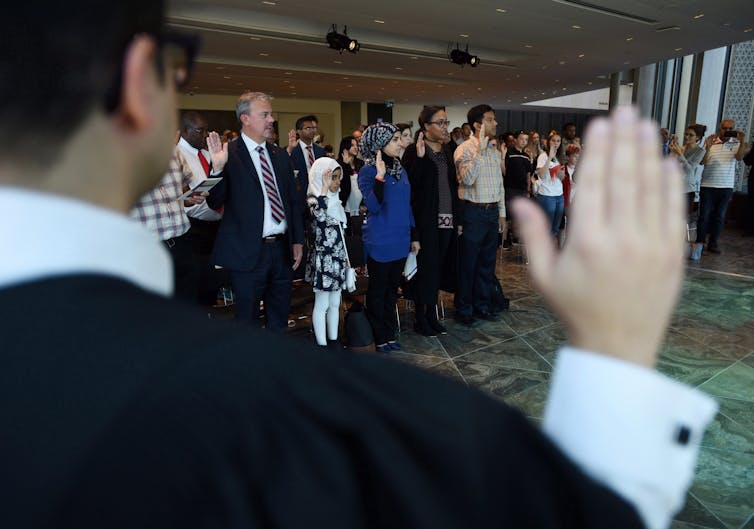
Unkept promises and unlearned lessons
In recent years, Canada has apologized for past discriminatory immigration measures and its treatment of Indigenous Peoples. And there have been recent symbolic advances recognizing First Nations, Inuit and Métis communities and Canadians’ treaty responsibilities in the citizenship oath.
However, social exclusions in modern forms related to the project of Canadian nation-building, citizenship and belonging persist. They are even intensifying in important respects.
A recent report from the Yellowhead Institute found that, despite an expressed commitment to fully implement the Truth and Reconciliation Commission’s 94 Calls to Action, the Federal government has only fulfilled 13, with those providing symbolic rather than structural remedies.
This example is indicative of why many Indigenous people — themselves denied the vote for much of Canada’s history — understandably view Canadian citizenship as, at best, a “kinder, gentler form of colonialism.”
These realities also remind us that the terms and hierarchies of citizenship and societal membership in Canada shift over time. They are subject to social struggle. And apologies and symbolic advancements do not relegate mistreatment to the past.
Hierarchies of belonging persist
“White Canada” immigration policies that favoured European immigrants and largely excluded those from elsewhere were in place until the 1960s.
These entrenched institutional and demographic dominance by white settlers. Europeans immigrating to Canada in earlier periods had ready access to permanent residence and eventual citizenship, unlike many of their contemporary racialized counterparts.
Institutional racism continues to be felt in the country’s immigration system and political life as tiers of citizenship and belonging continue to be practiced in old and new forms.
Canada adopted official multiculturalism in 1971, yet two years later it entrenched migrant worker programs, primarily for racialized workers from the Global South. As with past exclusions, these workers still have to navigate programs and realities that prevent or make it difficult for them to access permanent residence and citizenship.
This is particularly the case for those working in what are deemed to be “low skill” positions. Many such workers become “permanently temporary” despite ongoing demands for their labour.
Today, Canada’s political institutions are still disproportionately composed of men of primarily European descent. And they continue to set and enforce problematic terms of citizenship and societal membership.
Today’s more difficult pathways to citizenship
Today’s immigrants — who mostly come from the Global South — face a system of complex chutes and ladders when it comes to their status in Canada. That system leads many migrants to remain stuck in an immigration purgatory, far away from pathways to permanent residence, let alone citizenship.
Even those often characterized as the perfect immigrants — international students who pay vast sums that subsidize our post-secondary education system — face limited and precarious pathways to permanent residence and citizenship.
As economist Armine Yalnizyan recently noted, today for each person granted the security of permanent residence, there are two migrant workers or international students who have uncertain or no access to permanent status.
This could prove an obstacle to attracting and retaining workers. When it comes to citizenship and societal membership, it hinders inclusion by creating an exploitable class of workers who lack full political and social rights.
In the face of these realities, many migrants, students and workers are mobilizing to address these exclusions. This includes protests in several cities demanding “status for all” to mark the International Day for the Elimination of Racial Discrimination.

To return to the later stages of the process of becoming Canadian by adopting citizenship, under the former Conservative government, citizenship became harder to get and easier to lose by design.
Unfortunately, amidst the last decade’s battles between more exclusionary Conservative and rhetorically warmer Liberal visions of citizenship, tougher and more expensive procedures than previously existed remain under both.
The costs of applying for citizenship increased significantly under the Conservatives, and have remained prohibitive for many. The Trudeau government has made some positive reforms, such as reversing changes that made it take longer to become a citizen. But it has failed to follow through on its election promises to eliminate citizenship fees.
One recent study argues that it is likely that fee hikes and tougher, often expensive language requirements negatively impact a significant number of applicants.
Even those who have managed to obtain permanent residency and fulfilled their residency requirements face further “boundaries related to management flaws, classed naturalization, and cultural biases.” That means many, particularly refugee claimants and family class immigrants, struggle with the citizenship process.
For those who can reach the end of the process, some find it distasteful to continue to have to declare an enforced oath to a colonial figure, a reminder of the structures and hierarchies discussed in this article.
Given this context, the significant decline in Canada’s naturalization rate should be less surprising, though no less alarming as Canada continues to foster and even intensify inequalities of societal membership in its citizenship and immigration regime.![]()
John Carlaw, Postdoctoral Research Fellow under the Canada Research Chair (CERC) in Migration and Integration Program, Toronto Metropolitan University
This article is republished from The Conversation under a Creative Commons license. Read the original article.
Canada’s decision to ban TikTok from government devices is bad news for the NDP’s election strategy
Sunday, 19 March 2023 13:38 Written by theconversation 
Aidan Moir, University of Toronto
New Democratic Party leader Jagmeet Singh, the most prolific Canadian politician on TikTok with almost 900,000 followers, has deactivated his profile in a move that will undermine his party’s attempts to engage with young voters through social media.
On Feb. 27, Prime Minister Justin Trudeau announced TikTok would be banned on all federal-issued government devices due to security concerns over the Chinese-owned platform.
Trudeau’s decision follows similar bans in the United States by governments at the federal and state level, and numerous universities last December.
Singh has characterized his deactivation as “taking a pause” from the app, leaving open the possibility of reactivating his TikTok account in the future once the security concerns are addressed.
But in the meantime, a government ban on TikTok poses significant challenges for politicians and political parties, like Singh and the NDP, that use the platform for digital strategy within a permanent campaign model.
TikTok and the permanent campaign
The permanent campaign is an election campaign approach where politicians and their staff apply election tactics to everyday governance to continuously appeal to the public for support.
As part of their shift towards permanent campaigning, the NDP began hiring digital consultants, market researchers and public relations experts in 2000 to professionalize the party.
TikTok was an important element of the NDP’s permanent campaign strategy since the content was designed for Singh to stay visible on the platform in preparation for a snap election.
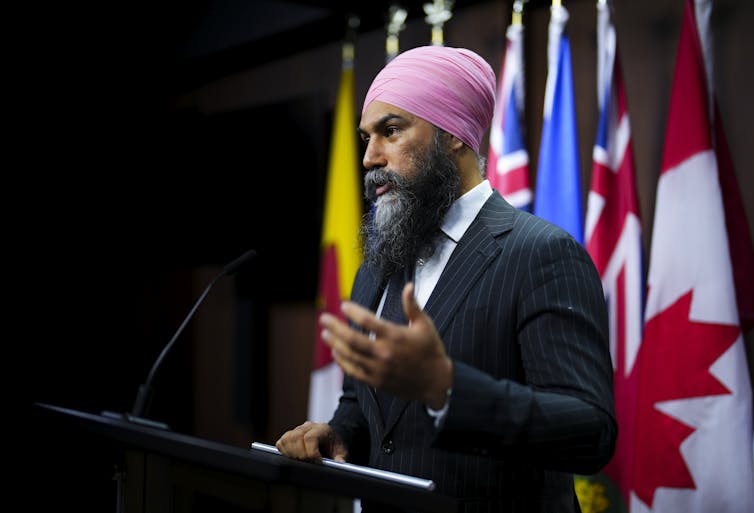
When the 2021 federal election was announced, there were only 11 candidates who had TikTok profiles, eight of whom were NDP candidates.
The NDP invested significant resources in building Singh’s TikTok presence, hoping platform virality would translate into future votes.
Singh’s TikTok celebrity

Singh launched his TikTok in August 2019 before the platform exploded in popularity in North America during the early months of the COVID-19 pandemic.
His second video, posted days before the October 2019 federal election, featured Singh promoting the NDP’s platform using the viral Nope Yup trend. Lip-syncing to the audio, a snippet of the song Choices by E-40, Singh’s TikTok went viral and accumulated almost 175,000 views within 72 hours.
Singh continued using TikTok as a vital component of the NDP’s digital strategy to reach young voters by highlighting the party’s social democratic platform. He posted content on issues ranging from Islamophobia in Canada to instructions on how to pronounce his first name.
His videos frequently used TikTok’s unique features such as audio, trends and challenges.
Singh’s most popular video had over eight million views. The video consisted of Singh using TikTok’s greenscreen function to participate in the Alors on Danse trend. Swaying in front of a group of young adults, text edited onto the video proclaimed: “When they say young people don’t vote but you know they’re going to make history in the next election.”
Singh’s TikTok again went viral, drawing press attention from The Globe and Mail. The Toronto Star proclaimed him a “TikTok Superstar.” The popularity of Singh’s TikTok showcased the playful persona that contributed to him being cited as the most liked federal party leader in Canada.

The memetic composition of his videos takes advantage of TikTok’s mysterious algorithm, which led to concerns about a lack of substance. Some videos have a gimmicky feel to them, which may be why the NDP’s 2021 election campaign debrief noted that Singh appeared to be less serious than other federal candidates.
Singh’s TikTok reflected the blurring boundaries between politicians and political influencers. A political influencer is an individual who becomes famous on the internet for posting politically oriented content on social media platforms.
Singh used TikTok to comment on events such as the January 2021 Capitol riots in a direct manner like other political influencers on the platform — an approach not typically suited to his official role as party leader.
Government TikTok ban
The government ban of TikTok on federal devices poses challenges for Singh’s digital outreach within the permanent campaign model. While Singh is active on platforms like Twitch and Instagram, the lively memetic style of his TikTok is difficult to replicate.
Young adults are increasingly receiving their news on TikTok rather than legacy media outlets. The app is a space where youth are active and Singh’s TikTok content was strategically designed to go viral and reach young users, who are vocal about many of the issues Singh supports.
Singh was one of the few politicians trying to reach these potential voters in a language and style they recognize. Singh’s use of TikTok to appeal to a youthful electorate was seen as a long-term investment in future votes. But now the potential impact of TikTok on the NDP’s election campaign strategy is under threat.![]()
Aidan Moir, Visiting Assistant Professor, Teaching Stream, University of Toronto
This article is republished from The Conversation under a Creative Commons license. Read the original article.
The U.S. is playing border politics again — this time with Canada
Sunday, 19 March 2023 13:31 Written by theconversation 
Laura Madokoro, Carleton University
Concern is reportedly growing among some American legislators about migrants crossing into the United States from Canada.
One recent headline intoned: “U.S. Republicans are now warning: Migration from Canada is a problem” as some lawmakers have likened the apparent trend to “being assaulted.”
Since Republican governors started to send migrants arriving in their states to Democrat jurisdictions in the summer of 2022, the question of border control has been a major subject of public policy discussions in the United States.
In Canada, this topic gained traction when it was revealed that some American public officials have been facilitating the movement of people to the Canadian border, particularly to the unofficial crossing at Roxham Road in Québec.
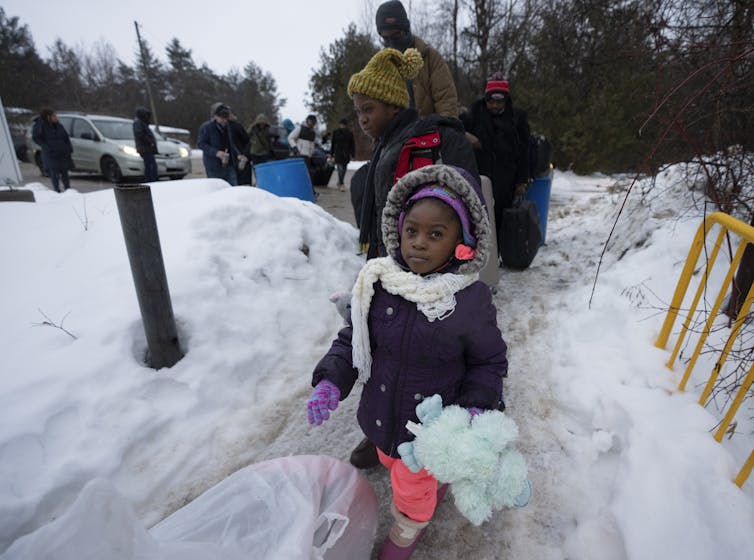
Public opinion polls, and heated rhetoric, are politicizing an issue that shouldn’t be political at all.
Since the rapid growth in the number of borders in the 19th century and the securitization and militarization of those borders in recent years, they’ve become a focal point in conversations about power and sovereignty. But they aren’t the real issue.
Borders simply offer an opportunity to score political points. In this case, it’s at the expense of migrants who have the right, under international law, to seek refuge.
Old anti-migrant playbook
By turning their attention to the Canada-U.S. border while also continuing to flag concerns about migration across the southern border with Mexico, American lawmakers are creating a perception that migration is a problem and polls show it’s reverberating domestically in Canada as well.
They’re also turning to a very old playbook in which migration across all borders is used to amplify the idea of migration as a threat.
In the 1880s, Canadian and American governments employed various measures to prevent both the continued migration of Chinese labourers to their shores as well as their permanent settlement.
Politicians had looked across the border (and across the Pacific to Australia) to see what kinds of measures were being envisioned elsewhere.
As historian Erika Lee has shown in her 2002 article in the Journal of American History, “Enforcing the Borders: Chinese Exclusion along the U.S. Borders with Canada and Mexico, 1882-1924,” this resulted in policymakers in the United States, in particular, using their ostensible concern about immigration issues as a way to deal with the so-called “Chinese problem.”
During that time period, the borders with both Canada and Mexico were seen as problematic by the United States, and migrants became the scapegoat in debates about American economic and social well-being. Crucially, this rhetoric was often racialized.
For example, Chinese migrants were depicted in editorials and editorial cartoons that featured gross distortions of their physical features and cultural practices.
By contrast, in the early 1900s, migrants from Syria, Greece, Hungary, Russia, France, Belgium and Spain were also known to have migrated to Canada first before making their way to the United States. This led to familiar complaints about Canada as a “back door” for entry to the United States, but in this case, the migrants themselves weren’t targeted.
But as Lee documented, they were often seen as the victims of “unscrupulous agents.”
Just as in the past, exploiting differences between migrants (in this case in terms of how they’re seeking refuge) creates greater inequalities and problems, and doesn’t attend to the core needs of migrants or potential host societies.
Larger systemic problems
The borders of the world are inextricably linked. What’s happening at the Canada-U.S. border is the result of growing numbers of dispossessed and displaced migrants globally and the failure of governments to grasp the fact that migrants themselves are not the problem.
Unfortunately, when people arrive in Canada uninvited — in other words, when they have not been selected in advance as part of a formal resettlement process — there is often visceral opposition. The presence of migrants at the border is seen as scary, in part because of the way this situation is presented by our neighbour to the south.
Given the history of the U.S.-Mexico border, and the highly militarized response to migrants arriving there, it’s not really a surprise that we’re now seeing similar anti-migrant rhetoric about the Canada-U.S. boundary too — and seeing lawmakers use words like “assault” to describe cross-border migration.

But border arrivals, whether on land or at sea, have often been met with considerable outcry. This was the case with migrants who arrived by boat in Canada in 1987 and 1999.
The exception was perhaps in 2017, when Donald Trump’s administration inspired generosity in Canadian politicians, with Prime Minister Justin Trudeau famously tweeting #WelcomeToCanada in response to the announcement of Trump’s so-called Muslim ban.
Border politics
The current outrage about migrants from Canada entering the U.S., however, harkens back to an earlier period when borders were politicized with the goal of exclusion in mind.
The fact that some American politicians are once again asserting that migration across the Canada-U.S. border is a problem, and are using heated rhetoric to try to score political points on the issue, is having the biggest impact on the people at the heart of these migrations.
As was the case for Chinese migrants beginning in the 1880s, migrants are being exploited for partisan, nationalistic purposes. The potential for enduring harm is great.
All people have the right to seek refuge — indeed, the “right to seek asylum” and “enjoy in other countries asylum from persecution” is enshrined in the United Nations’ Universal Declaration of Human Rights, though the means to seek this right are less explicitly outlined.
Seeking to get political mileage out of a situation that stems from an ongoing global crisis and involves innocent people seeking better lives ignores bigger political, social, legal and economic conditions. Rather than demonize migrants, legislators everywhere should address the issues that lead them to migrate.![]()
Laura Madokoro, Associate Professor, Department of History, Carleton University
This article is republished from The Conversation under a Creative Commons license. Read the original article.
Iraq 20 years on: researchers assess how US invasion shapes lives today – podcast
Friday, 17 March 2023 23:57 Written by theconversation 
Mend Mariwany and Nehal El-Hadi, The Conversation
On March 19, 2003, the United States led an unlawful invasion into Iraq — at the time, the reason given was the search for weapons of mass destruction. The U.S. occupation of Iraq lasted over eight years, until the official withdrawal of troops throughout 2011.
While the number of deaths as a result of the U.S.-led occupation of Iraq has been difficult to accurately calculate, it is estimated that around 405,000 deaths occurred as a direct result. Most of these deaths were of Iraqi civilians. Hundreds of thousands of others were injured, and over nine million displaced.
Initially, this was due to the U.S. invasion, then as a result of continued conflict due to the sectarian violence that followed between 2006 and 2010, and finally because of the Islamic State group’s occupation in parts of the country from 2013-17.
In this episode of The Conversation Weekly, we speak to two researchers who examine the impact the invasion and conflict have had on the lives of Iraqis.
Sana Murrani Associate Professor in Spatial Practice and Deputy Director for the Doctoral College for the Arts, Humanities and Business at the University of Plymouth, United Kingdom. Originally from Baghdad, Murrani fled Iraq shortly after the 2003 U.S.-led invasion. As part of her research, she has focused on how people cope with the traumatic effects of war.
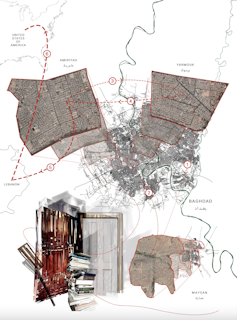
“Iraqis wake up to a very different landscape every single day,” she points out. “And they engaged with that landscape to have to go to work, to school.”
Murrani interviewed 15 people across Iraq about their lives since the U.S. invasion. These collected narratives will be published in a forthcoming book and featured (Bloomsbury, 2024) in an upcoming exhibition. Ruptured Domesticity: A visual narrative of domestic responses to war in Iraq will be on display at the London School of Economics in the U.K.
For the exhibition, Murrani created collages and maps to visualize the stories of the people she interviewed, which will also be accessible virtually.

“I think these stories and memories and traumas that have certainly only appeared for a very brief moment under the spotlight,” Murrani explains. “And I’m thinking that this will bring back a focus on Iraq for a bit, for people to understand what has become of a country after 20 years of invasion and traumas.”
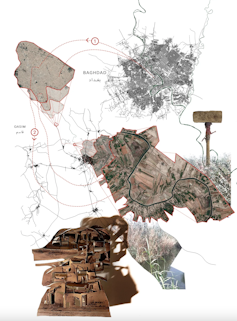
Inna Rudolf is a senior research fellow at the International Centre for the Study of Radicalisation and a postdoctoral research fellow at the Centre for the Study of Divided Societies, King’s College London in the U.K. As part of her research, Rudolf has conducted interviews with Iraqis to understand how contested narratives surrounding decades of conflict have impacted the memory of various communities and their identities.
“What we found out that in order for projects to contribute to social and psychological healing, they need to bring individuals together, and to create a context in which these individuals can perceive each other as humans again. Iraqis from different communities need to recognise that they were all affected by the violence and that each group carries its own scars, which need time and conditions to heal.”
Rudolf says that once the people recognize each other’s pain, Iraqis can begin to heal their communities and their country.
“Each community wants its own victimhood to be heard, understood and acknowledged. And the more they feel that they are pushed into one category, or that their own suffering is not being taken seriously either by their counterparts, by their co-nationals or by the Iraqi government, the more feelings of alienation are likely to prevail over feelings of belonging to the state as equal citizens.”
Many Iraqis want to be able to move on in order to contribute in meaningful ways to their society and actively shape their future, as Rudolf found out.
Listen to the full episode of The Conversation Weekly to find out more.
This episode of The Conversation Weekly was produced and written by Mend Mariwany, who is also the show’s executive producer. Sound design is by Eloise Stevens, and our theme music is by Neeta Sarl.
You can find us on Twitter @TC_Audio, on Instagram at theconversationdotcom or This email address is being protected from spambots. You need JavaScript enabled to view it.. You can also subscribe The Conversation’s free daily email here.
Listen to “The Conversation Weekly” via any of the apps listed above, download it directly via our RSS feed or find out how else to listen here.![]()
Mend Mariwany, Producer, The Conversation Weekly and Nehal El-Hadi, Science + Technology Editor & Co-Host of The Conversation Weekly Podcast, The Conversation
This article is republished from The Conversation under a Creative Commons license. Read the original article.
Popular News
Famous US lawyer Alex Murdaugh found guilty of murdering wife and son
Monday, 06 March 2023 02:28 Written by lindaikejiblog
A popular South Carolina, USA lawyer
Richard "Alex" Murdaugh has been found guilty of killing his wife and son.
A jury on Thursday, March 2 convicted the once-influential attorney of murder in a case that has gripped America's attention for nearly two years.
The 12-person jury declared Murdaugh, 54, guilty on two counts of murdering his wife Maggie, 52, and youngest son, Paul, 22, who were executed at close range near the dog kennels on their family estate on the evening of June 7, 2021. He was also convicted of two related firearms charges.

Murdaugh showed no emotion as the jury foreperson read the verdict, which the panel reached after three hours of deliberations. He was then led out of the courtroom with his hands cuffed.
His lawyer immediately motioned for a mistrial, which the judge swiftly denied.

"The evidence of guilt is overwhelming," South Carolina Circuit Court Judge Clifton Newman said.
Murdaugh, the whose family eas an influential legal family, had pleaded not guilty, though he admitted to lying about his alibi and to committing to an array of financial crimes in confessions that dented his credibility with the jury.
With the guilty verdict, Murdaugh faces 30 years to life in prison for each of the two counts of murder when he is sentenced on Friday.
The case has drawn intense media coverage given the family's immense political power in and around Colleton County, where the trial took place. For decades until 2006, family members served as the leading prosecutor in the area, and Murdaugh was a prominent personal injury attorney in the Deep South state.
Throughout the trial, prosecutors portrayed Murdaugh as a serial liar and argued that only he had the means and the opportunity to commit the murders. Prosecutors said he gunned down his wife and son to distract from his financial crimes, including the theft of millions of dollars from his law partners and clients - money used to feed a years-long addiction to opioids and support an expensive lifestyle.
Among the state's strongest evidence against the disgraced lawyer was Murdaugh's admission from the stand last week that he lied about his whereabouts on the night of the killings, telling investigators he wasn't at the dog kennels before the murders. Murdaugh changed his account after the jury listened to audio evidence placing him at the crime scene minutes before the killings occurred.
"It doesn't matter who your family is, it doesn't matter how much money you have," Creighton Waters, the lead prosecutor, said after the verdict. "If you do wrong, if you break the law, if you murder, then justice will be done in South Carolina."
Murdaugh's lawyers tried to paint their client as a loving family man who, while facing financial difficulties and suffering from an opioid addiction that led him to lie and steal, would never harm his wife and child.
They floated alternative theories, with Murdaugh testifying that he believed someone angry over a deadly 2019 boating accident involving Paul likely sought revenge on his son.
Jim Griffin, one of the defense lawyers, described the state's alleged motive as preposterous during his closing argument on Thursday, arguing the murders would have only drawn more scrutiny to Murdaugh's financial misdeeds.
Griffin also accused investigators of fabricating evidence and repeatedly stressed that the state must prove guilt beyond a reasonable doubt, underscoring the challenge facing prosecutors who built their case largely on circumstantial rather than direct evidence.
Despite the strong defense, jurors did not believe Murdaugh's account. Prosecutors focused on Murdaugh's credibility, coming back time and again to his admission that he lied about something as critical as where he was when his wife and child were killed.
Judge Newman told jurors they made the right call.
"Circumstantial evidence, direct evidence -- all of the evidence pointed to only one conclusion, and that’s the conclusion that you all reached," he said.
Working more and making less: Canada needs to protect immigrant women care workers as they age
Monday, 06 March 2023 01:52 Written by theconversation
Naomi Lightman, Toronto Metropolitan University and Hamid Akbary, University of Calgary
The pandemic has heightened Canadians’ awareness of the 3D jobs — dirty, difficult and dangerous — done by many migrant workers in our communities.
When the pandemic first struck, many of these workers were on the front line working in essential services. Engaged in low-wage work in health and child care, immigrant care workers had high rates of COVID-19 infections, while also experiencing widespread job losses and continuing financial struggles to make ends meet.
Our recent paper in the Journal of Aging and Social Policy reveals troubling realities for immigrant women care workers as they age. We found that immigrant women aged 65 and over who entered Canada through the (Live-in) Caregiver program work more but make less than other comparable immigrant women. The required live-in component was removed in 2014 and the program has since been split into two pilot programs.
These findings are crucially important given Canada’s rapidly aging population and increasing concern about senior poverty in racialized communities.

Working past retirement age
In Canada, we have long known that it is disproportionately racialized immigrant women (specifically Black and Filipina women) who do challenging and devalued work as carers. We also know that jobs like personal support workers, home health aides and child-care workers are still usually associated with “women’s work” and tend to have low wages.
However, what we have not known is whether these women continue to experience these disadvantages later in life. Specifically, we have very little information about the financial challenges immigrant women care workers in Canada face as they age.
On the one hand, it is plausible that care workers are more likely than other workers to continue working past the typical retirement age because of their relatively low wages and limited savings.
On the other hand, due to the physically and emotionally demanding nature of care work, which can be detrimental to their health, care workers may be less likely to continue working past age 65 and have higher rates of eligibility for government low-income supports.
Our recent research tried to clarify the situation of immigrant care workers as they age. We examined 11 years of Statistics Canada data from 2007-2017 to compare the income sources and trajectories of immigrant women who entered Canada through three migrant entry programs.
We used Statistics Canada’s Longitudinal Immigration Database to unpack how the gendered and racialized devaluation of caring occupations disadvantages immigrant women as they age. The database is a comprehensive source of administrative data that includes information on the socio-economic status of tax-filing immigrants since their arrival in Canada.
The data show that care workers are more likely to be employed after the age of 65 than other immigrant women, but have a lower and declining total income as they age.
Furthermore, while care workers receive higher rates of government pension benefits, they tend to have lower levels of private pension savings. And the cumulative income they report shows a relative decline over time.

Prioritizing care workers as they age
So what does this all mean? Our study underscores serious concerns about government investment in alleviating senior poverty. The conditions of low-wage care workers, before and after retirement, must be prioritized.
The package of pension supports available in Canada, which includes Old Age Security, the Guaranteed Income Supplement and the Canada Pension Plan, does not offset the decline in earnings immigrant care worker women face as they age.
That means there is a need to enhance policies that address senior poverty, recognizing that immigrant care worker women are among Canada’s most vulnerable populations. These women experience intersectional disadvantages as immigrants, women and racialized minorities.
Our findings also reinforce the need for more full-time, permanent and well-paying jobs in the Canadian care sector. As of 2017, the unemployment rate of female immigrants in Canada was nearly double that of their Canadian-born counterparts. Recent research finds that the pandemic increased rates of unemployment and led to shifts to precarious work for many immigrant women in Canada.
The federal government must enhance access to and the amount of money provided through the Guaranteed Income Supplement to address senior poverty within underserved communities. Any government invested in reducing social inequalities and protecting vulnerable senior populations must consider the financial challenges immigrant care worker women face as they age and equalize their income over time with other comparable groups. And we, as the electorate, must do our part to keep governments accountable to this goal.
Ultimately, immigrant women are doing the essential jobs that most Canadians rely on. They are caring for our elderly, sick or young family members when we are in need.
It is the very least we can do to ensure that immigrant women care workers are able to age with financial security, dignity and adequate social protections.![]()
Naomi Lightman, Associate Professor of Sociology, Toronto Metropolitan University and Hamid Akbary, Postdoctoral Fellow, Department of Sociology, University of Calgary
This article is republished from The Conversation under a Creative Commons license. Read the original article.
US congratulates Tinubu on his win at the 2023 Presidential election
Thursday, 02 March 2023 05:00 Written by lindaikejiblog
The United States of America has congratulated Bola Ahmed Tinubu of the APC on his victory at the 2023 presidential election.
Independent National Electoral Commission (INEC), on Wednesday March 1, declared Bola Tinubu, of the All Progressives Congress (APC), winner of February 25 presidential elections, over main opposition candidates, Atiku Abubakar of the PDP and Peter Obi of LP.
A statement released by United States Department spokesman, Ned Price, read;
"The United States congratulates the people of Nigeria, president-elect Tinubu and all the political leaders.”
“This competitive election represents a new period for Nigerian politics and democracy.”
Price also acknowledged the discontent among some Nigerians over the validity of the results.
“We understand that many Nigerians and some of the parties have expressed frustration about the manner in which the process was conducted,” he said.
“Nigerians are clearly within their rights to have such concerns and should have high expectations for their electoral process.”
“We call on all parties to refrain from violence or inflammatory rhetoric at this critical time,” Price added.
US congratulates Tinubu on his win at the 2023 Presidential election
Thursday, 02 March 2023 04:54 Written by lindaikejiblog
The United States of America has congratulated Bola Ahmed Tinubu of the APC on his victory at the 2023 presidential election.
Independent National Electoral Commission (INEC), on Wednesday March 1, declared Bola Tinubu, of the All Progressives Congress (APC), winner of February 25 presidential elections, over main opposition candidates, Atiku Abubakar of the PDP and Peter Obi of LP.
A statement released by United States Department spokesman, Ned Price, read;
"The United States congratulates the people of Nigeria, president-elect Tinubu and all the political leaders.”
“This competitive election represents a new period for Nigerian politics and democracy.”
Price also acknowledged the discontent among some Nigerians over the validity of the results.
“We understand that many Nigerians and some of the parties have expressed frustration about the manner in which the process was conducted,” he said.
“Nigerians are clearly within their rights to have such concerns and should have high expectations for their electoral process.”
“We call on all parties to refrain from violence or inflammatory rhetoric at this critical time,” Price added.








